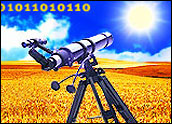
The planet Venus will create a rare spectacle on Tuesday when it passes directly in front of our sun, creating an image for viewers on Earth that won’t be repeated until the year 2117.
Known as “the 2012 Transit of Venus,” the nearly seven-hour journey will begin at 3:09 p.m. Pacific Daylight Time (22:09 UT) Tuesday and will be widely visible around the globe. Observers on seven continents will be in a position to see it, in fact — including even a sliver of Antarctica.
Ideal viewing conditions will be in the mid-Pacific, where the sun is high overhead during the crossing. In the United States, the transit will be best viewed at sunset, treating those on Earth to a rare view of what NASA describes as “the swollen red sun ‘punctured’ by the circular disk of Venus.”
To avoid burning their eyes, viewers of the event must not watch the transit directly. Instead, they can watch using a projection technique or a solar filter. A No. 14 welder’s glass can also work well, according to NASA.
NASA Television will air a live program starting at 5:30 p.m. EDT on Tuesday showcasing the celestial phenomenon.
‘The Relative Tilt of the Orbit’
“These transits are rare,” Scott Austin, associate professor of astronomy and director of the astronomical facilities at the University of Central Arkansas, told TechNewsWorld.
Venus actually ends up between Earth and the sun every 1.6 years, Austin pointed out.
The majority of those conjunctions don’t result in transits, however, “due to the relative tilt of the orbit of Venus relative to the orbit of the Earth,” he explained.
‘This Doesn’t Happen Often’
Indeed, “the way the orbits of the planets wobble and the fact that Earth has to be in exactly the right position with respect to the sun and Venus mean this doesn’t happen that often,” noted Paul Czysz, professor emeritus of aerospace engineering at St. Louis University.
Venus and Earth are roughly the same size, Czysz told TechNewsWorld, but Venus goes around the sun faster than Earth does because it’s closer to it.
“You have to be exactly in the right place and at the right time” to see the transit, he added. So does the sun, for that matter, so that Venus’s transit can be made visible by daylight.
A Long History
Humans have long been entranced by Transits of Venus, not just for their beauty and rarity but also for scientific reasons.
The Babylonians and Mayans were able to predict exactly when such events would happen on the basis of observation alone, Czysz pointed out.
Later, in the 18th century, “observations of the transit were used to get estimates of distances within the solar system,” Mario Livio, senior astrophysicist with the Space Telescope Science Institute, told TechNewsWorld.
At that time, the size of the solar system was one of science’s biggest mysteries.
“Venus transits have been historically scientifically significant for determining the apparent diameter of Venus and its distance,” noted Austin.
‘Layers of the Venusian Atmosphere’
This year’s transit may not be quite as central to our understanding of distances in the solar system, but it’s by no means devoid of scientific import.
“This transit will allow planetary scientists to study certain layers of the Venusian atmosphere by observing the light from the Sun passing through those layers,” Austin explained.
“This will help refine this technique when applied to extrasolar planets that are observed to transit their parent stars,” he added.
‘No One Alive Had Seen a Transit’
Transits of Venus come in pairs separated by more than a hundred years. Tuesday’s transit is the “bookend” of an eight-year pair, with the last occurring in June 2004.
For that last one, no one alive at the time had seen a Transit of Venus with their own eyes, NASA noted, and the hand-drawn sketches and grainy photos of previous centuries scarcely prepared them for what was about to happen.
Modern solar telescopes captured an unprecedented view of the event then — and this time around the view should be even better.
Looking at ‘Moonshine’
This year’s transit will be observed by NASA’s Solar Dynamics Observatory, and it will also be observed indirectly by the Hubble Space Telescope, Livio pointed out.
“Hubble will be observing the moon to look at ‘moonshine’ — the reflection of the sun’s light by the lunar surface,” he explained.
“By comparing data in and out of transit, information will be gathered on Venus’ atmosphere,” Livio noted.
Astronaut Don Pettit will also photograph Tuesday’s Transit of Venus from the International Space Station, with photos posted to Flickr along the way. Pettit and the Expedition 31 crew will be the first people in history to see a Venus transit from space.
‘You’d Burn a Hole’
Perhaps most important of all is that viewers don’t try to watch the transit directly, because tiny Venus covers too little of the sun to block out its blinding glare.
“If you use binoculars, you could burn your eyes,” Czysz warned. “With telescopes as large as they are today, you’d burn a hole right through a piece of wood.”
Instead, viewing must be done through special solar filters or at a planetarium or observatory that’s equipped for solar viewing and open for the event, noted Austin, whose observatory at UCA is among those hosting a special viewing.
At such facilities, the image of the transit is “run through a series of lenses” and projected, Czysz pointed out, so “you’re not looking at any image directly.”
Our ‘Last Chance’
In any case, there’s no doubt taking the necessary safety precautions will be well worth the trouble.
“Given that the next transit is not until December of 2117,” Livio said, “this is most probably the last chance of anybody alive today to actually see a transit.”





















































